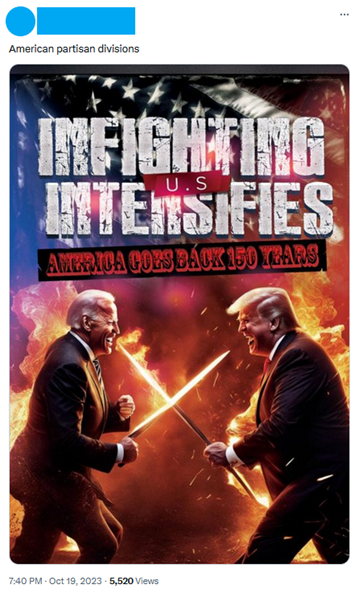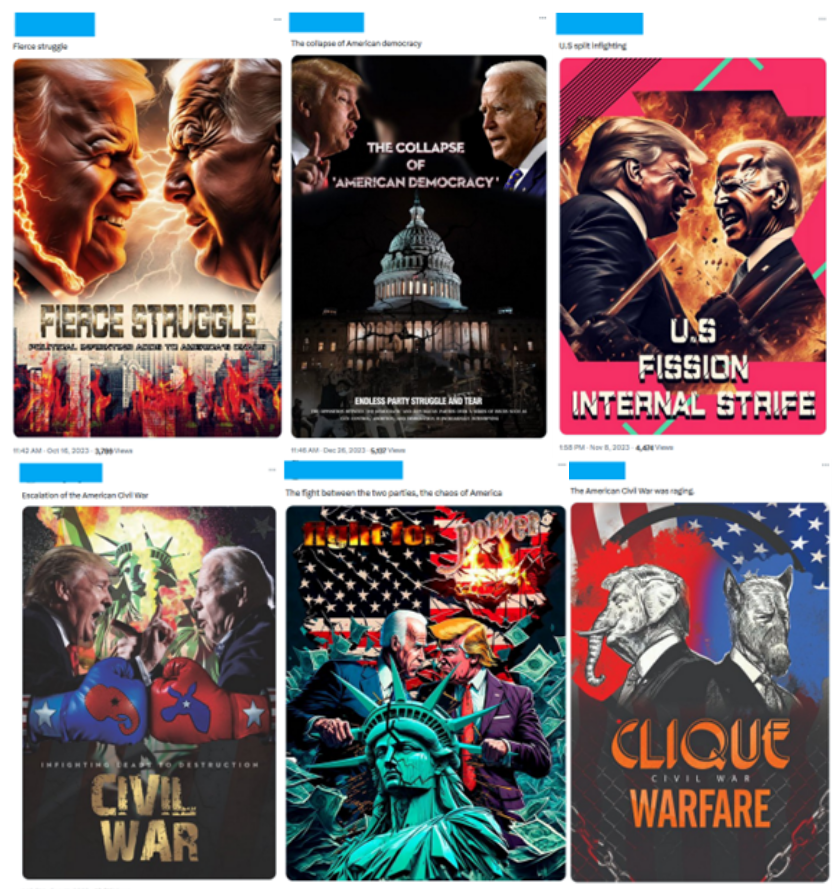Pro-CCP ‘Spamouflage’ network pivoting to focus on US Presidential Election
15 February 2024
By: Elise Thomas
In a year when almost half of the world’s population will be asked to go to the polls, arguably no election will be more globally consequential than the US Presidential election in November. Foreign interference in the elections of 2016 and the roiling domestic divisions of 2020 will cast a long shadow over the race in 2024.
The long-running influence campaign suspected to be run by the CCP and often referred to as ‘Spamouflage’ is already pivoting to focus on the expected competition between President Joe Biden and Republican forerunner Donald Trump. Spamouflage has been active since at least 2017. In April 2023 the US Department of Justice charged 40 employees of the Chinese Ministry of Public Security’s 912 Special Projects Working Group for their involvement in an influence campaign which, based on details in the indictment, appears extremely likely to be Spamouflage. According to the indictment, the operation is coordinated from Beijing and implemented in offices around China. It is infamous among researchers both for its sprawling size and for its failure to generate any noteworthy engagement from real social media users.
Analysing the narratives of the campaign is nonetheless useful as a method for understanding the likely broader strategy of the CCP going into the election year. It is also important to continue to keep an eye on Spamouflage’s tactics as they evolve. Some recent developments in new tactics from part of the Spamouflage network will be explored in an upcoming Dispatch.
Even as this shift is occurring, most of the network is continuing to operate as usual. This includes using a network of accounts to share original images (which are now often AI generated, although in some cases more traditional photo editing tools like Photoshop also continue to be used) to illustrate the narrative being promoted.

Figure 1: Example of an AI-generated ‘movie poster’ shared by a Spamouflage account on X, with the text “American partisan divisions.”
This Dispatch will focus on content shared by Spamouflage on X, formerly known as Twitter. Spamouflage is also active on YouTube, Facebook, TikTok, Medium and literally dozens of other forums, websites and social media platforms. However, lax content moderation enforcement on X is now allowing the operation to proliferate significantly on the platform, in comparison to others which are continuing to push back against Spamouflage.
As of January 2024, Spamouflage’s election-related content appears to be focused solely on Joe Biden and Donald Trump as the expected candidates in the Presidential election. ISD’s research has not identified content focusing on any of the other candidates in the Republican primary, or any potential Democratic challengers to President Biden.
While there are narratives targeting both expected candidates, as of January 2024, the majority of the attacks are targeted at President Biden. It is unclear whether this is simply because he is currently in office or if it reflects a preference for the electoral outcome. Interestingly, narratives relating to Trump are somewhat ambiguous in that – from the perspective of Trump supporters – they could be interpreted as positive. Again, it is not clear whether this is an intentional strategy.
However, the bulk of the content appears aimed at creating a sense of dismay over the state of America without any clear partisan bent. It focuses on issues like urban decay, the fentanyl crisis, dirty drinking water, police brutality, gun violence and crumbling infrastructure. These are not election-specific narratives and have been a significant feature of Spamouflage’s content over several years. While not explicitly linked to the election, however, this content clearly also feeds into the attempt to create a sense of dissatisfaction with the state of the country among voters, as well as potentially engendering a sense of chaos in the US amongst international audiences.
Key narratives include:
The election will be divisive and damaging for America: This appears to be one of the two most common election-specific narratives being promoted by Spamouflage. It portrays the election as a source of division and strife which compounds America’s existing problems. Most of the images associated with this narrative picture Trump and Biden face to face, perhaps reflecting the prompts which the AI model was given. The images may be composites of AI generated and photoshopped.

Figure 2: Examples of Spamouflage graphics emphasising partisan and political division due to the election.
Negative Biden narratives: Alongside painting the election as divisive, negative narratives about President Biden appear to be the other most significant focus of Spamouflage’s election-related efforts as of January 2024. As mentioned above, it is unclear whether this reflects a strategic goal of CCP-aligned networks or is simply because Biden is the current President.
The scandals, legal cases and conspiracy theories linked to Biden’s son, Hunter, feature heavily in the attack narratives, as do implications that Biden is corrupt, a drug user and a liar.
Ambiguous Trump narratives: Narratives relating to Trump are noticeably less common than those relating to Biden. Interestingly many of them are also somewhat ambiguous – while the authors may intend them to be negative, Trump supporters might read many of them differently.
The examples below, such as “Trump’s status as an anti-hero is making him unstoppable,” “Trump indicted again: America’s dark day” and “Twitter warrior” would potentially be received by Trump supporters as positive. It is unclear whether this ambiguity is intentional, or the result of a misapprehension on the part of the Chinese operators about the nature of Trump’s appeal to his supporters.

Figure 4: Examples of Spamouflage graphics sharing somewhat ambiguous narratives about former President Trump.
Both candidates are too old, especially Biden: This narrative is predominately targeted at Biden, but has been featured as a separate narrative here because it does in some cases refer to both presumptive presidential candidates as too old.

Figure 5: Examples of Spamouflage graphics sharing somewhat ambiguous narratives about former President Trump.
Election fairness and integrity: As of January 2024, casting doubt on the integrity and fairness of the election itself does not appear to be a major focus of the campaign (yet). A relatively small amount of content is focused on this narrative – for example, in the month of January 2024 one Spamouflage account posted 21 times, with just one post focused on this topic. It is nonetheless a significant narrative to watch for given the experience with the 2020 election and the array of conspiracy theories and hyper-partisan polarisation around the issue of election integrity in 2024.
Abortion: As of January 2024, there is relatively little content relating to specific policy issues in the context of the election. The exception to this is the issue of abortion, which has been the subject of a small amount of content which claims that Biden is not doing enough to protect abortion rights, while Trump will ban the right to an abortion on a federal basis.
Civic and urban decay: There is a lot of content portraying the state of the US as dire, with a rampant opioid crisis, mass homelessness, out–of–control gun violence and other social malaises. This content is not currently placing these issues in a partisan or electoral context, however.

Figure 8: Examples of Spamouflage graphics containing negative representations about the state of homelessness and drug abuse in the US.
Discussion
There is no indication that these fairly standard election-related efforts by Spamouflage are, as a whole, having any more success at generating real engagement than their previous campaigns. Most tweets receive either no engagement and very low numbers of views, or are only engaged with by other accounts which appear to be a part of the Spamouflage network.
Nonetheless, these narratives provide a useful window into the approach which CCP propaganda operations are taking at this early stage in the US electoral cycle: amplifying dismay and division; attacking President Biden including through personal smears and disinformation; and seemingly soft-pedalling on former President Trump.
While this business-as-usual approach is generating the usual level of returns (i.e. none), a small number of Spamouflage accounts appear to be experimenting with different strategies. A future Dispatch will explore this partial shift in tactics and its implications.






